Fans of early horror will have no problem identifying names like Boris Karloff, Tod Browning, Bela Lugosi, Lon Chaney Jr., and James Whale as very important figures in laying the groundwork for the genre for years to come. But what about Tod Slaughter and George King? I’m sure only a smattering of these same people would recognize the names, and I counted myself among those that didn't have a clue until a couple of months ago. 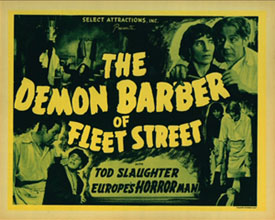 England’s answer to the Universal horror pictures of the same era, the duo collaborated on six films together (some claim eight, but I can’t seem to find any concrete information on the other two), and Sweeney Todd: The Demon Barber of Fleet Street, their first foray with one another, is without question their most well known.
England’s answer to the Universal horror pictures of the same era, the duo collaborated on six films together (some claim eight, but I can’t seem to find any concrete information on the other two), and Sweeney Todd: The Demon Barber of Fleet Street, their first foray with one another, is without question their most well known.
Mr. Sweeney Todd, a barber whose shop is nestled on London’s famous Fleet Street, is a man with aspirations of wealth and aristocracy. To achieve this, he isn’t above murder. His shop is located near a port in which numerous men of some stature utilize for international travel, and with the promise of a fresh shave, something the men haven’t had in some time sailing the seas, lures them back to his shop. Once there, he sends his helper, who is an orphan boy that Sweeney takes on for the money as well as the free labor, next door to Mrs. Lovatt’s pie shop for a pie. This isn’t just to get rid of the boy; Mrs. Lovatt is involved with Sweeney, and this is her cue to step into action. Once alone with the customer, Sweeney flips a switch which opens a trap door underneath the barber chair and drops the unsuspecting victim to their doom. Down in the basement, which is connected to the pie shop, Mrs. Lovatt disposes of the body and along with Sweeney enjoys the fruits of their bounty.
With the money Sweeney Todd is accumulating, he buys into ownership of a new ship with a man named Stephen Oakley. The deal isn’t what it seems on the surface however, as Sweeney’s main reason for doing so is his interest in Oakley’s daughter Johanna. After threatening to pull out of the deal and claiming full ownership of the new ship unless Oakley coerces Johanna into a marriage with him, Sweeney gets his wish. Johanna of course is unhappy, as she awaits the love of her life, Mark Ingerstreet, to return from a voyage abroad. 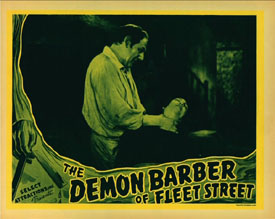 When he does, he returns a wealthy man, and this of course interests Sweeney; in fact, it works out better than he could have ever imagined, as he can eliminate the one thing standing between him and Johanna as well as make some money. So he lures Mark back to his shop, and dumps him down into the basement. Surprisingly though, while Mark is unconscious, he’s still alive. Mrs. Lovatt isn’t too happy about Sweeney’s new love interest, so she helps the man escape, which puts a lot of kinks in Sweeney Todd’s plans.
When he does, he returns a wealthy man, and this of course interests Sweeney; in fact, it works out better than he could have ever imagined, as he can eliminate the one thing standing between him and Johanna as well as make some money. So he lures Mark back to his shop, and dumps him down into the basement. Surprisingly though, while Mark is unconscious, he’s still alive. Mrs. Lovatt isn’t too happy about Sweeney’s new love interest, so she helps the man escape, which puts a lot of kinks in Sweeney Todd’s plans.
On the downside, the film isn’t extremely polished. Made in a time when England, due to the influx of American imports, was trying to protect its film industry by instituting a quota system that stated a certain percentage of films shown in England had to be produced there, Sweeney Todd was obviously made on the cheap and the quick to add to 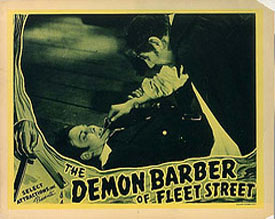 that percentage. Many cuts in the film are less than subtle, showing that the editor probably didn’t have many different takes to work with and had to use whatever was at his disposal to capture a full scene. As such, there are numerous occasions where a cut will take place right in the middle of a scene, and the placement of furniture and even the actors move to a different different spot. Still, the atmosphere and the presence of Slaughter is more than enough to overlook these shortcomings.
that percentage. Many cuts in the film are less than subtle, showing that the editor probably didn’t have many different takes to work with and had to use whatever was at his disposal to capture a full scene. As such, there are numerous occasions where a cut will take place right in the middle of a scene, and the placement of furniture and even the actors move to a different different spot. Still, the atmosphere and the presence of Slaughter is more than enough to overlook these shortcomings.
Also probably due to the low budget, a scene late in the film, where Sweeney Todd’s obsession Johanna disguises herself as an orphan boy looking for work to get close to Sweeney is almost an embarrassment. The disguise consists of boys clothes, some slicked back hair, and a few handfuls of dirt thrown onto her face. But what do you know, Sweeney buys it, hook, line and sinker! Surely a man who was so enraptured with the woman would see through this paltry costume, but he doesn’t. It’s not like the film is supposed to be taken seriously and based in reality (Slaughter's portrayal of Mr. Todd sees to that), but sometimes an oversight like this, even in the most unbelievable of films, is hard to swallow and gets stuck in my craw, and this was one of those moments.
Regardless of these issues, Tod Slaughter puts on one hell of a show here, and even if you’ve seen this story told before, Slaughter’s take on the character should be seen, especially for fans of classic horror cinema. He may very well have captured the role better than anyone else, and while the story itself may be predictable, Slaughter is anything but.
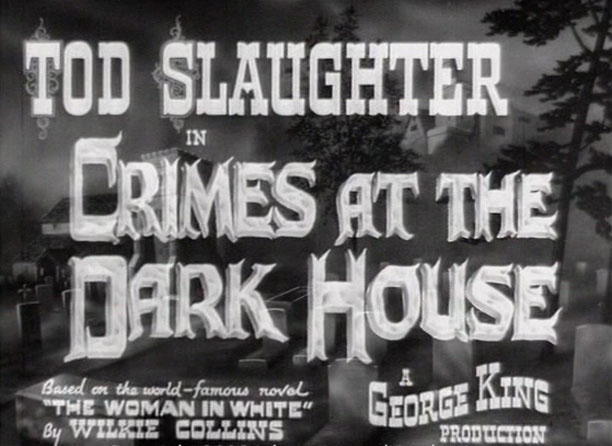
Sweeney Todd: The Demon Barber of Fleet Street hit a chord in England, and Slaughter went on to steal the show in countless other crime and horror films, a good amount of them along with director George King. Their final foray together was Crimes at the Dark House, based on Wilkie Collins 1859 story The Woman in White, and the experience they gained over the year’s shows through. The film is a much more polished production, and the duos chemistry is at an all-time high.
Crimes at the Dark House opens with a man, who could only be Tod Slaughter, driving a metal stake into a sleeping mans head. They appear to be on some sort of job abroad, and that’s confirmed when a ship docks and off steps the madman now assuming the role of Sir Percival Glyde, a rich heir who was the man he just recently knocked off. A devious plan indeed, but once arriving at his estate, he finds out that the man whom he’s impersonating  is in debt up to his ears, so much so that he could end up in prison. Now stuck, he decides to make the most of it while he can, and sparks up an affair with one of the housemaids. He also befriends a local land owner and persuades him to offer his daughter Laurie up for marriage. This is a wonderful opportunity to make some money and get himself out of the hole he realizes he’s gotten into.
is in debt up to his ears, so much so that he could end up in prison. Now stuck, he decides to make the most of it while he can, and sparks up an affair with one of the housemaids. He also befriends a local land owner and persuades him to offer his daughter Laurie up for marriage. This is a wonderful opportunity to make some money and get himself out of the hole he realizes he’s gotten into.
As always, things don’t go as planned, and the housemaid becomes pregnant, and with enough monetary woes already as well as his new marriage, Glyde disposes of her accordingly. Just in time too, as a doctor and a grief-stricken woman show up at the manor, claiming that she’s married to Glyde and their insane daughter has recently escaped a mental institution. Things go from bad to worse when the doctor sniffs out Glyde and becomes privy to his plan. He also notices that his new wife is a spitting image of his “daughter” who has escaped. Seeing a blackmail opportunity in the works and being just as money hungry as Glyde, the doctor suggests he gets Laurie to sign a paper that would turn her fortune over to Glyde, and then have her institutionalized.
I’m sure the synopsis sounds like a convoluted mess, but the story actually comes together quite nicely, especially considering it clocks in at under 70 minutes. Some of the more long-winded directors out there could learn a thing or 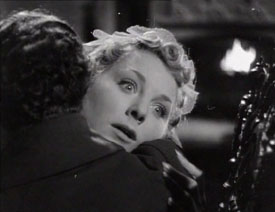 two about pacing if they watched this film, which proves that longer is not always better, and that a good, compact script can deal with multiple story threads just as well as any other.
two about pacing if they watched this film, which proves that longer is not always better, and that a good, compact script can deal with multiple story threads just as well as any other.
Less a horror film and more of a crime/drama, Slaughter still hams it up like no other, and brings just as much gusto to the role of the false Sir Percival Glyde as he always does. His eccentricities and nuances are in full force, and he delivers some of the best lines I’ve heard in a while (while sporting a curled-upward mustache), including “I’ll feed your entrails to the pigs!” and “You wanted to be a bride? I’ll make you a bride…a bride of death!” Honestly, how can anyone not enjoy a film like this? The rest of the cast does a serviceable job, and are a bit more important to the overall proceedings than they were in Sweeney Todd, but it’s hard to even pay attention to anyone else when Slaughter is on screen. He demands you take notice, and it’s nearly impossible to ignore his orders.
If you call yourself a fan of the original wave of talkie horror flicks and the likes of Karloff and Lugosi, and you don’t know Tod Slaughter, it’s high time you remedy that little problem. Every bit as influential as the larger names, and reveling in roles that others would look down upon, Slaughter is a force unto himself, and is absolutely undeniable. Crimes at the Dark House is among his best work, and once you lay eyes on him, you won’t be able to look away, and you’re not likely to find as much delightfully evil fun anywhere else.
Raunchy Tonk offers up both of these overlooked gems as part of a double feature disc. Due to its better recognition (and I’m sure Burton’s recent adaptation as well), Sweeney Todd takes top billing. The 1.33:1 presentation looks pretty good for a forgotten film that’s fallen into the public domain and was produced on the cheap. The contrast leaves something to be desired occasionally, and there’s some unsurprising print damage, but overall it does look to have been restored to an extent, and not just thrown out there without much thought like many public domain films are. The audio track has a consistent hiss throughout, but it’s not overbearing and is forgotten about easily. Crimes at the Dark House, which is offered as a bonus feature, actually fares a bit better. Maybe it’s because it’s nearly 5 years younger, but the print is in better shape, and the black levels stay consistent at a much better rate. The hiss on the audio is also less prevalent.
Extras include an interview with Johnny Legend, where he talks about his appreciation of Slaughter and these films, gives a bit of background history, and how excited he is to finally give the films a respectable DVD release. There’s some interesting insight here, although you may go into an epileptic fit thanks to the blinking light behind his head. This is followed by a short reel of horror flick trailers including the German Krimi Dead Eyes of London and the cheesy It! starring Roddy McDowall. The coolest extra comes way of an old radio recording of Slaughter and some of his cohorts relaying a tale of terror that’s quite entertaining. The disc is rounded off with a stills gallery featuring images from some of Slaughter’s films.
Please feel free to discuss "Crimes at the Dark House" here, in our forums!

